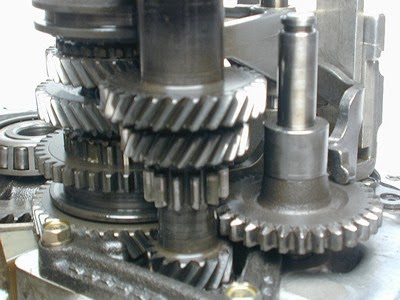WHY DOES MANUAL TRANSMISSION CAR MAKE A LOUD WHIRRING NOISE IN REVERSE?
Manual transmissions use mostly helical gears, but reverse is a special situation that requires a different type of gear - a spur gear.
The gears that make up the forward gear ratios are all helical gears. The teeth on helical gears are cut at an angle to the face of the gear. When two teeth on a helical gear system engage, the contact starts at one end of the tooth and gradually spreads as the gears rotate, until the two teeth are in full engagement. This gradual engagement makes helical gears operate much more smoothly and quietly than spur gears. Also, because of the angle of the gear teeth, more teeth are in engagement at any one time. This spreads the load out more and reduces stresses.
The only problem with helical gears is that it is hard to slide them in and out of engagement with each other. On a manual transmission the forward gears stay engaged with each other at all times, and collars that are controlled by the shift stick lock different gears to the output shaft (see How Manual Transmissions Work for details). The reverse gear on your manual transmission uses an idler gear (the large spur gear visible at the right side of the picture below), which has to slide into mesh with two other spur gears at the same time in order to reverse the direction of rotation.
Spur gears, which have straight teeth, slide into engagement much more easily than helical gears, so the three gears used for reverse are spur gears>
Each time a gear tooth engages on a spur gear, the teeth collide instead of gently sliding into contact as they do on helical gears. This impact makes a lot of noise and also increases the stresses on the gear teeth. When you hear a loud, whirring noise from your car in reverse, what you are hearing is the sound of the spur gear teeth clacking against one another!
















0 comments:
Post a Comment